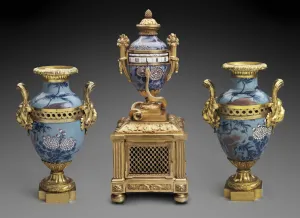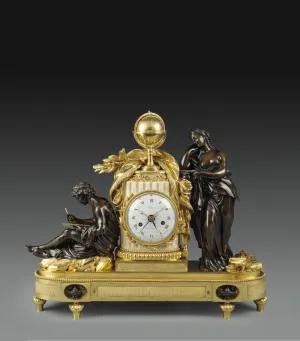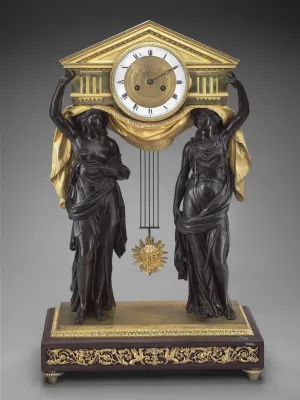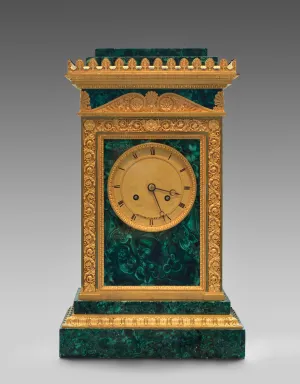Horace Wood Brock Collection
Case by Charles Cressent (1685−1768)
Movement by Jean-Baptiste Delaroche (dates unknown)
Spring-Driven Pendulum Clock on a Bracket
Paris, c. 1735
Gilt bronze, enameled metal, and glass
44 1/2 in. high x 18 1/8 in. wide (113 cm high x 46 cm wide)
Horace Wood Brock Collection
This four-legged clock standing on a wall bracket was designed and made by Charles Cressent, a leading French furniture-maker and sculptor. Clocks offered many creative possibilities for the artisans, as the only limitation was the dial. Free to create whatever composition he wished, Cressent designed clock cases that approached pure sculpture. In this example in chased and gilt bronze, dragons fight over a lion’s head. Combined with abstract motifs of irrational scale and asymmetric design, the piece is crowned by a winged child on clouds.
Clock movement by Jean Martin (active 1737−1786)
Porcelain: Chinese, Qing dynasty, Qianlong period (1736−95)
Garniture of One Clock and Two Vases
Paris, c. 1764
Hard-paste porcelain known as celadon bleu fleuri, gilt bronze, and enameled metal
Clock: 21 in., diameter: 8 in. (53.3 cm, diameter: 20.3 cm)
Vases: 14 in., diameter: 9 in. each (35.6 cm, diameter: 22.9 cm)
Horace Wood Brock Collection
Although by the eighteenth century mechanisms had become both reliable and accurate, clocks continued to function as important status symbols indicating their owners’ wealth and refinement. This set is made with three vases in the rare Chinese porcelain known as celadon bleu fleuri. Soon after they reached France, the vases were embellished with gilt-bronze mounts and a movement by Jean Martin in an attempt to satisfy French collectors’ perpetual quest for increasingly more elaborate and novel luxury items.
Renacle-Nicolas Sotiau (1749–1791)
Figures after Simon-Louis Boizot (1743–1809)
Mantel Clock Representing Study and Philosophy
Paris, c. 1785–90
Patinated and gilt bronze, marbre, enameled metal, and glass
22 1/2 x 21 13/16 x 5 1/2 in. (57.2 x 53.8 x 14 cm)
Horace Wood Brock Collection
Although the pendulum clock was invented in 1653 by the Dutch mathematician Christiaan Huygens (1629–1695), its development took place in England and France. This scientific revolution transformed clocks into precise timekeepers that were both decorative and functional. Around 1669 a special type of escapement was invented that enabled pendulum clocks to keep time within a few seconds. While the British designed the case around the movement, the French gave increasing importance to the case.
Lenoble à Paris (dates unknown)
Gilt-bronze mounts attributed to François Rémond (1747–1812)
Pediment Clock
Paris, c. 1790
Patinated and gilt bronze, glass
31 5/8 x 19 3/8 x 8 1/4 in (80.3 x 49.2 x 21 cm)
Horace Wood Brock Collection
This imposing clock exemplifies the role played by sculpture in the design of clock cases in late eighteenth-century France. Two caryatids in black bronze, draped in antique style, were modeled by an unknown sculptor who studied classical architecture. They support the upper part of a Greek temple, in the manner of the Erechtheion in Athens, built between 421 and 406 bc.
Jean-François Denière (1774−1866)
Malachite and Gilt-Bronze Mantel Clock
Paris, c. 1810
Malachite and gilt bronze
17 x 10 1/16 x 6 1/2 in
Horace Wood Brock Collection
At their meeting at Tilsitt in June 1807, the French Emperor Napoleon received from the Russian Tsar Alexander I several magnificent gifts, including many malachite pieces that were later mounted in gilt-bronze by François-Honoré-Georges Jacob-Desmalter after designs by the architects Charles Percier and Pierre-François Fontaine. Soon after, malachite mounted with gilt-bronze became fashionable among members of the First Empire’s high society.





